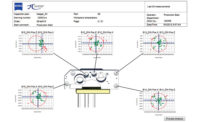NEW YORK - Results from the second annual Sustainable Design Trend Watch Survey, jointly commissioned by the American Society of Mechanical Engineers (ASME) and Autodesk Inc., indicate that mechanical engineers expect to see an increase in sustainable design work in 2010.
Despite the challenging economy, respondents indicate with a 6% increase over last year that they believe sustainable design will be further incorporated into their work in 2010. The survey also reported for the second consecutive year that more than two-thirds of participating mechanical engineers have worked on sustainable products, and more than half of ASME student members are involved with sustainable design in their studies.
The survey is conducted to understand the effects of sustainable design on mechanical engineers and their manufacturing businesses in industries ranging from aerospace and automotive to energy and transportation. According to survey results, designs that use less energy or reduce emissions remain the most important sustainable technology practice, while manufacturing processes that use less energy and natural resources were also a priority.
“The results of this important ASME-Autodesk survey demonstrate that sustainable design practices are exerting a positive influence on the mindset of engineers at all levels,” says Thomas G. Loughlin, executive director of ASME. “Going forward, engineers will be at the forefront in creating sustainable technologies that produce large-scale impacts worldwide.”
“There is no question that sustainable design is a priority for mechanical engineers, and Autodesk collaborates with ASME on this survey to highlight the importance of making smarter, more sustainable design decisions at every step of the design process,” says Robert “Buzz” Kross, senior vice president, manufacturing industry group at Autodesk.
One example of a manufacturer incorporating sustainable design practices is Ohio-based Unverferth Manufacturing Co. Inc. Unverferth is a leading, family-owned manufacturer of agricultural and farming equipment, including a full line of tillage products, which worked to adapt its products to the soil conditions of different geographies.
Using Digital Prototyping, Unverferth has decreased the number of physical prototypes it builds by 75%. In doing so, the company decreased materials usage for prototypes from 230 to 60 metric tons annually. In addition, Unverferth has reduced product weight by 5% through more efficient use of materials.
The survey indicates that top drivers of sustainable design practices within organizations include regulatory requirements, rising energy costs and client demand. Along with creating designs that use less energy and reduce emissions, respondents indicated that priorities include improving manufacturing processes to use fewer resources; using renewable, recyclable and recycled materials; and reducing material waste in manufacturing.
Similar to last year, respondents again indicated that cost is a major consideration, with one-third of respondents reporting they would consider sustainable technologies for new products only if they are cost saving.
The online surveys of more than 53,000 ASME professionals and nearly 20,000 ASME student members were conducted over a two-week period that concluded in November 2009. The questionnaire generated more than 3,000 respondents in the United States. About 65% of the professional engineer respondents had more than 20 years of engineering career experience, with more than 20% focusing on the design and development of products, systems or equipment.
Get our new eMagazine delivered to your inbox every month.
Stay in the know with Quality’s comprehensive coverage of the manufacturing and metrology industries.
SIGN UP TODAY!Copyright ©2024. All Rights Reserved BNP Media.
Design, CMS, Hosting & Web Development :: ePublishing


